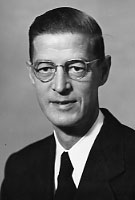
Brother Thaddeus Revers, MM
Born: December 21, 1912
Oath: September 29, 1940
Died: August 29, 1987
Thomas Henry Revers, son of Henry and Eva Dietz Revers, known in Maryknoll as Brother Thad, was born in Oberlin, Ohio, on December 21, 1912. At the age of 75 he died at St. Teresa’s Residence on Saturday, August 29, 1987. In 1929 he had visited Maryknoll and later wrote on his application: “I have always had an inclination for the missions and I became especially interested when I visited Maryknoll and through the influence of my uncle, Father Frederick Dietz, M.M.” He entered after high school in 1932 and took Final Oath on Sept. 29, 1940.
Brother Thad had widespread experience as a missioner. He went wherever his skills were needed. His first assignment was to Japan in 1937. In 1939 he was assigned to Hong Kong. In 1946 he went to Tepic, Mexico until 1948 when he was recalled to work in various houses in the U.S. Besides being known as a master carpenter, Brother Thad was an artist. One report of a visitation states: “His hobby of wood-inlay and statue-molding does not interfere with his regular duties but keeps him fully occupied. He has carved some excellent statues of Our Lady of Wisdom, St. Michael and other statuettes much appreciated by priests, brothers and students. This activity has aroused the interest of a number of the students.” Some of his works decorate the halls of Maryknoll to this day. In all his assignments he was known to be happy and satisfied. Whatever he was called upon to do, from the digging of graves to the delicate repairing of wood carvings, Brother excelled. In personnel evaluations he was considered by his superiors “one of the better members of the community with ability to organize and direct work groups.
During World War II, Brother Thad was interned with the other Americans at the Stanley Internment Camp. In October of 1942 he was released and allowed to live in Bethany Retreat House operated by the Paris Foreign Mission Society. In February, 1943, he was able to arrive safely at one of the Maryknoll missions in Chungking, under the direction of Fr. Mark Tennien, in the interior of China. Conditions kept moving him further into the interior. At the request of the Bishop, he accompanied a group of Maryknoll Sisters from Wuchow to Kwangsi and wrote: “As I was in Wuchow, the Bishop asked me to take the Sisters here (Kwangsi). We left that night by boat but with flooded rivers and washed out train rails it took us 19 days.”
Brother was able to make his way to Kunming, the end of the Burma Road. There, about 20 Maryknollers, driven out of their missions, were working as chaplains. He recounts: “I was with them only a couple of months before being called to the States. I took a train across India from Calcutta to Bombay and then boarded an Army transport bound then for the U.S.” He arrived in March, 1945.
After a short rest he was assigned to Tepic, Mexico. The conditions there were as primitive as any other place he had ever been. He wrote: “While my work in China had been hectic because of the war, I found the Tepic mission more interesting. There was an opportunity to build something out of nothing. No matter what we could do for the people, how little we might be able to give them, it was more than they would have otherwise. Those Indians were really the poorest of God’s poor. While there was not outright starvation, as I had seen in China among the refugees, life in Tepic was on a much more primitive level.” He wrote to his parents: “At present we are living under the roughest conditions I ever saw in a Maryknoll mission, but, little by little, we are getting it fixed up. We are living in a two-room mud and stone house, with mud floor and straw roof. At night you can be in bed and see the stars. So far, the weather has been fine but the nights are cold. I have a good Army Arctic sleeping bag and when I get zipped up in it at night, I don’t care what happens. We are on friendly terms with the people. We’re looking around for ground and I have been out hunting clay for tile and brick, and good timber for lumber. I found some clay and today I made my first bricks. After the bricks are dried a week, they have to be burnt and, from the samples I made, I think they will come out all right.”
In 1948 Thad was assigned back to the U.S. where his talents were put to use in the many Maryknoll houses throughout the country.
Reflecting on the vocation of the Brothers, he wrote,”There’s always more than enough work for Brothers. Anyone who wants to use his talents to the fullest can do just that as a Brother. Wherever he is and whatever he does, he has reason to be proud of his work because he is contributing something essential to the most important business in the world – that of saving souls.” Bro. Thad has done just that.
